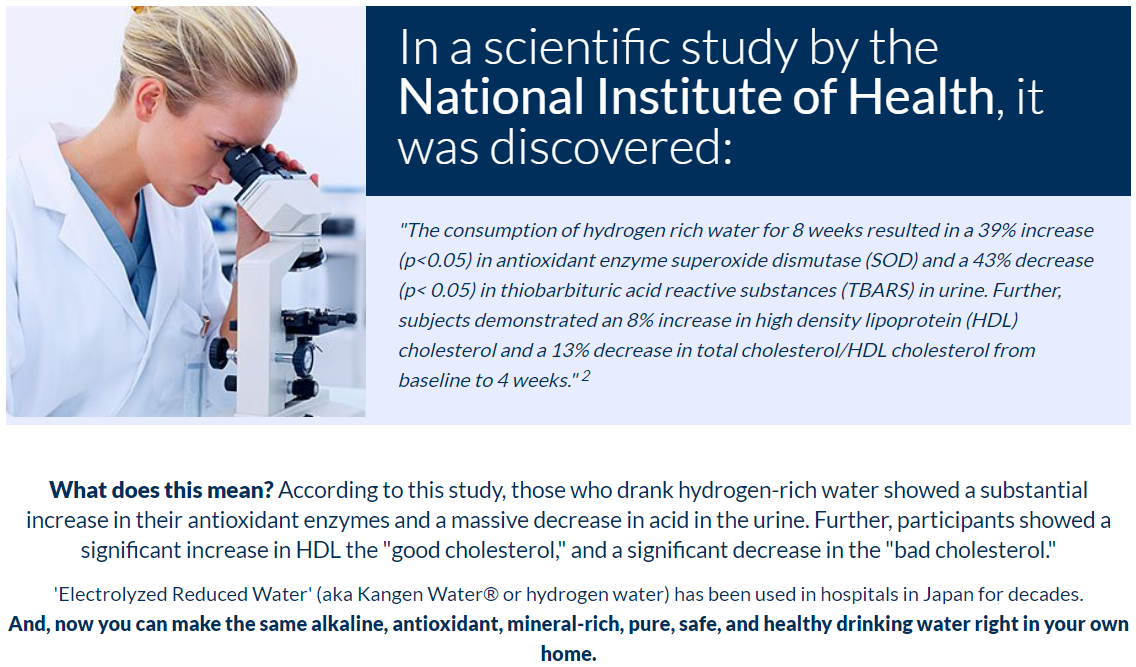There are thousands of researches and clinical studies on this technology. Here are some of those researches:
In a scientific study by the National Institute of Health, it was discovered:
“The consumption of hydrogen rich water for 8 weeks resulted in a 39% increase (p<0.05) in antioxidant enzyme superoxide dismutase (SOD) and a 43% decrease (p< 0.05) in thiobarbituric acid reactive substances (TBARS) in urine. Further, subjects demonstrated an 8% increase in high density lipoprotein (HDL) cholesterol and a 13% decrease in total cholesterol/HDL cholesterol from baseline to 4 weeks.”
What does this mean? According to this study, those who drank hydrogen-rich water showed a substantial increase in their antioxidant enzymes and a massive decrease in acid in the urine. Further, participants showed a significant increase in HDL the “good cholesterol,” and a significant decrease in the “bad cholesterol.” ‘Electrolyzed Reduced Water’ (aka Kangen Water® or hydrogen water) has been used in hospitals in Japan for decades.
And, now you can make the same alkaline, antioxidant, mineral-rich, pure, safe, and healthy drinking water right in your own home.
https://www.ncbi.nlm.nih.gov/pmc/articles/PMC2831093/
Kangen Water
Generic Names on Research Studies: Electrolyzed reduced/reducing water, Hydrogen rich water, Antioxidant water
Micro Clustering
How Ions Affect the structure of Water
Faculty of Chemistry and Chemical Technology, University of Ljubljana, Askerceva 5, 1000 Ljubljana, Slovenia.
The two main ideas captured here are (1) that charge densities govern the interactions of ions with water, and (2) that a balance of forces determines water structure: electrostatics (water’s dipole interacting with ions) and hydrogen bonding (water interacting with neighboring waters). Small ions (kosmotropes) have high charge densities so they cause strong electrostatic ordering of nearby waters, breaking hydrogen bonds. In contrast, large ions (chaotropes) have low charge densities, and surrounding water molecules are largely hydrogen bonded.
http://www.ncbi.nlm.nih.gov/pubmed/12371874
Digestion and Elimination
Selective stimulation of the growth of anaerobic microflora in the human intestinal tract by electrolyzed reducing water
Department of Physiology of Microorganisms, Biology Faculty, Lomonosov Moscow State University, Moscow, Russia
Many disease of the intestines are due to a disturbance in the balance of the microorganisms in the gut. Dr. Vorbjea and his team at Moscow State University found favourable evidence indicating that electrolyzed water specifically encourages the growth of residential (good) microflora in the gut.
https://pubmed.ncbi.nlm.nih.gov/15617863/
Antioxidant Effects
Enhanced induction of mitochondrial damage and apoptosis in human leukemia HL-60 cells due to electrolyzed-reduced water and glutathione
Electrolzyed-reduced water (ERW) is a higher pH and lower oxidation-reduction potential water. In the present study, we examined the enhanced effect of ERW in the apoptosis of leukemia cells (HL-60) induced by glutathione (GSH).
These results suggest that ERW is an antioxidant, and that ERW, in combination with GSH, has an enhanced apoptosis-inducing effect on HL-60 cells, which might be mediated through the mitochondria-dependent pathway.
https://pubmed.ncbi.nlm.nih.gov/19202298/
Electrolyzed hydrogen-saturated water for drinking use elicits an antioxidative effect: a feeding test with rats
A new type of electrolyzed hydrogen-saturated (EHS) water was produced using a water-electrolyzing device equipped with a special cation exchanger. Use of the EHS water for drinking in a feeding test with rats elicited an antioxidative effect. After intraperitoneal injection of 2,2-azobis-amidinopropane dihydrochloride, urinary secretion of 8-hydroxydeoxyguanosine and hepatic formation of peroxidized lipid were significantly lessened in rats which had received the EHS water for one week. These results suggest the possibility that this drinking water shows an effect in reduction of oxidative stress in the body.
http://www.ncbi.nlm.nih.gov/pubmed/16244454
Strong Acidic Water
Generic Names on Research Studies: Acidic Electrolyzed water, Strong acidic electrolyzed water, Electrolyzed Oxidizing Water
Toxin Free Cleaning
Efficacy of electrolyzed water and an acidic formulation compared with regularly used chemical sanitizers for tableware sanitization during mechanical and manual ware-washing protocols
Department of Food Science and Technology, The Ohio State University
This study investigated residual bacteria and different food types left on tableware items after various washing and sanitization protocols. Escherichia coli K-12 and Staphylococcus epidermidis were inoculated into whole milk and soft cream cheese. The milk was used to contaminate regular drinking glasses and the cheese was used to contaminate plates and silverware.
This study revealed that NEW and the acidic formulation are as effective as the other chemical sanitizers for food contact surface sanitization in manual and mechanical ware washing.
http://www.ncbi.nlm.nih.gov/pubmed/19610348
Personal Hygiene
Antimicrobial effects and efficacy on habitually hand-washing of strong acidic electrolyzed water–a comparative study of alcoholic antiseptics and soap and tap water
Sakashita M, Iwasawa A, Nakamura Y. – Department of Nursing, Showa University Fujigaoka Hospital
The rate of bacterial elimination for the stamp method was compared with regular hand-washing (using soap and tap water), hygienic hand-washing (using alcoholic antiseptics), and hand-washing using strong acidic electrolyzed water (the SAEW method) in routine work on patient’s body.
The rate of bacteria elimination for hand-washing with soap and tap water after taking care of a patient was insufficient.
From these results, the following manual for sanitary hand washing is recommended: 1. At first, dirty hands should be cleaned and the number of bacteria should be reduced using soap and tap water or by scrubbing with disinfectants. 2. After the number of bacteria has been reduced, use the SAEW method routinely.
http://www.ncbi.nlm.nih.gov/pubmed/12073573
Food preparation
Reduction of Escherichia coli O157:H7 on produce by use of electrolyzed water under simulated food service operation conditions
Pangloli P, Hung YC, Beuchat LR, King CH, Zhao ZH – Department of Food Science and Technology, University of Georgia
Treatment of fresh fruits and vegetables with electrolyzed water (EW) has been shown to kill or reduce foodborne pathogens. We evaluated the efficacy of EW in killing Escherichia coli O157:H7 on iceberg lettuce, cabbage, lemons, and tomatoes by using washing and/or chilling treatments simulating those followed in some food service kitchens.
Application of AcEW using procedures mimicking food service operations should help minimize cross-contamination and reduce the risk of E. coli O157:H7 being present on produce at the time of consumption.
https://pubmed.ncbi.nlm.nih.gov/19777886/
Strong Kangen Water
Generic Names on Research Studies: Electrolyzed reducing water with pH 11.6, Alkaline Electrolyzed Water
Reduction of pesticide residues on fresh vegetables with electrolyzed water treatment
Jianxiong Hao, Wuyundalai, Haijie Liu, Tianpeng Chen, Yanxin Zhou, Yi-Cheng Su, Lite Li
Degradation of the 3 pesticides (acephate, omethoate, and dimethyl dichloroviny phosphate [DDVP]) by electrolyzed water was investigated. These pesticides were commonly used as broad-spectrum insecticides in pest control and high-residual levels had been detected in vegetables.
Our research showed that the electrolyzed oxidizing (EO) water (pH 2.3, available chlorine concentration:70 ppm, oxidation-reduction potential [ORP]: 1170 mV) and the electrolyzed reducing (ER) water (pH 11.6, ORP: -860 mV) can reduce the pesticide residues effectively.
Moreover, we found that the residual level of pesticide residue decreased with prolonged immersion time. Using EO or ER water to wash the vegetables did not affect the contents of Vitamin C, which inferred that the applications of EO or ER water to wash the vegetables would not result in loss of nutrition.


